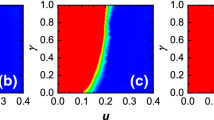Abstract
We consider two-state automata playing repeatedly the Prisoner's Dilemma (or any other 2 × 2-game). The 16 × 16-payoff matrix is computed for the limiting case of a vanishingly small noise term affecting the interaction. Some results concerning the evolution of populations of automata under the action of selection are obtained. The special role of “win-stay, lose-shift”-strategies is examined.
Similar content being viewed by others
References
Aumann, R. (1981) Survey of repeated games, in Essays in Game Theory and Mathematical Economy in Honor of Oskar Morgenstern, Wissenschaftsverlag, Bibliographisches Institut, Mannheim
Axelrod, R. (1984) The Evolution of Cooperation, Basic Books, New York (reprinted 1989 in Penguin, Harmondsworth)
Axelrod, R. (1987) The evolution of strategies in the iterated Prisoner's Dilemma, in Davis, D. (ed.) Genetic Algorithms and Simulated Annealing, Pitman, London
Axelrod, R. and Hamilton, W.D. (1981) The evolution of cooperation, Science 211, 1390–6
Axelrod, R. and Dion, D. (1988) The further evolution of cooperation, Science 242, 1385–90
Abreu, D. and Rubinstein, A. (1988) The structure of Nash equilibria in repeated games with finite automata, Econometrica 56, 1259–82
Banks, J. S. and Sundaram, R. K. (1990), Repeated games, finite automata and complexity, Games and Economic Behaviour 2, 97–117
Binmore, K. G. and Samuelson, L. (1992) Evolutionary stability in repeated games played by finite automata, Journal of Economic Theory 57, 278–305
Boyd, R. (1989) Mistakes allow evolutionarily stability in the repeated Prisoner's Dilemma game, J. Theor. Biol. 136, 47–59
Brannath, W. (1994) Heteroclinic networks, on the tetrahedron, Nonlinearity 7, 1367–1384
Esam, E. (1995) The trembling hand approach to automata, to appear
Guyer, M. and Perkel, B. (1972) Experimental games. A bibliography 1945–71, Communication Nr. 293, Mental Health Research Inst., Univ. of Chicago
Hofbauer, J. and Sigmund, K. (1988) The Theory of Evolution and Dynamical Systems, Cambridge UP
Kraines, D. and Kraines, V. (1988) Pavlov and the Prisoner's Dilemma, Theory and Decision 26, 47–79
Lindgren, K. (1991) Evolutionary phenomena in simple dynamics, in Artificial life II (ed. C. G. Langton et al), Santa Fe Institute for Studies in the Sciences of Complexity Vol. X, 295–312
May, R. M. (1987), More evolution of cooperation, Nature 327, 15–17
Maynard Smith, J (1982) Evolution and the theory of games, Cambridge UP
Miller, J. H. (1989) The evolution of automata in the Repeated Prisoner's Dilemma, working paper of the Santa Fe Institute Economics Research Program
Nowak, M. and Sigmund, K. (1992) Tit for tat in heterogeneous populations, Nature 355, 250–2
Nowak, M. and Sigmund, K. (1993a) Chaos and the evolution of cooperation, Proc. Nat. Acad. Science USA, 90, 5091–5094
Nowak, M. and Sigmund, K. (1993b) Win-stay, lose-shift outperforms tit-for-tat, Nature, 364, 56–58
Nowak, M. and Sigmund, K. (1994) The alternating Prisoner's Dilemma, Journal of Theoretical Biology 168, 219–226
Probst, D. A. (1993) Evolution, automata and the repeated Prisoner's Dilemma, to appear
Rapoport, A. and Chammah, A. (1965) The Prisoner's Dilemma, Univ. of Michigan Press, Ann Arbor
Rapoport, A., Guyer, M. and Gordon, D. (1976) The 2 × 2 game, Univ. of Michigan Press, Ann Arbor
Rubinstein, A. (1986) Finite automata play the repeated Prisoner's Dilemma, Journal of Economic Theory 39, 83–96
Selten, R. (1975) Reexamination of the perfectness concept for equilibrium points in extensive games, Int. J. Game Theory 4, 25–55
Selten, R. and Hammerstein, P. (1984), Gaps in Harley's argument on evolutionarily stable learning rules and in the logic of tit for tat, Behavioural and Brains Sciences 7, 115–116
Sigmund, K. (1995) Games of Life, Penguin, Harmandsworth
Author information
Authors and Affiliations
Rights and permissions
About this article
Cite this article
Nowak, M.A., Sigmund, K. & El-Sedy, E. Automata, repeated games and noise. J. Math. Biol. 33, 703–722 (1995). https://doi.org/10.1007/BF00184645
Received:
Revised:
Issue Date:
DOI: https://doi.org/10.1007/BF00184645




